Driving Source of Change for Ionosphere before Large Earthquake -Vertical Ground Motion-
Abstract
1. Introduction
2. Space Weather Situation
3. Analysis of Hi-Net Data
4. Relation among Kp Index, NmF2, and Total Power
5. Latitude Variation of NmF2
6. Discussion
7. Conclusion and Future Tasks
Author Contributions
Funding
Data Availability Statement
Acknowledgments
Conflicts of Interest
References
- Liu, J.Y.; Chen, Y.I.; Chuo, Y.J.; Chen, C.S. A statistical investigation of pre-earthquake ionospheric anomaly. J. Geophys. Res. 2006, 111, A054304. [Google Scholar] [CrossRef]
- Singh, C.; Singh, O.P. Simultaneous ionospheric E- and F-layer perturbations caused by some major earthquakes in India. Ann. Geophys. 2007, 50, 111–122. [Google Scholar] [CrossRef]
- Liu, J.Y.; Chen, C.H.; Chen, Y.I.; Wang, W.H.; Oyama, K.I.; Kuo, K.W. A statistical study of ionospheric earthquake precursors monitored by using equatorial ionization anomaly of GPS TEC in Taiwan during 2001–2007. J. Asian Earth Sci. 2010, 39, 76–80. [Google Scholar] [CrossRef]
- Liu, J.Y.; Chen, C.H.; Tsai, H.F. A statistical study on ionospheric precursors of the total electron content associated with 146 M > 6.0 earthquakes in Japan during 1998–2011. In Earthquake Prediction Studies: Seismo Electromagnetics; Hayagawa, Ed.; TERRAPUB: Tokyo, Japan, 2014; pp. 1–13. [Google Scholar]
- Astafyeva, E.; Heki, K. Vertical TEC over seismically active region during low solar activity. J. Atmos. Sol. Terr. Phys. 2011, 73, 1643–1652. [Google Scholar] [CrossRef]
- Devi, M.; Barbara, A.K.; Kashyap, P.; Depueva, A.; Ruzhin, Y.Y.; Depuev, V. Earthquake time low latitude TEC and model estimated values: Identification on earthquake induced atmospheric dynamics. Adv. Geosci. 2011, 27, 69–84. [Google Scholar]
- Mokhamad, N.G.; Heki, K. Ionospheric disturbances of the 2007 Bengkulu and the 2005 Nias earthquakes, Sumatra, observed with a regional GPS network. J. Geophys. Res. 2013, 118, 1777–1787. [Google Scholar] [CrossRef]
- Akhoondzadeh, M.; Parrot, M.; Saradjian, M.R. Electron and ion density variations before strong earthquakes (M 6.0) using DEMETER and GPS data. Nat. Hazards Earth Syst. Sci. 2010, 10, 7–18. [Google Scholar] [CrossRef]
- Oyama, K.-I.; Kakinami, Y.; Liu, J.Y.; Abdu, M.A.; Cheng, C.Z. Anomalous Ion Density Latitudinal Distribution as a precursor of large earthquake. J. Geophys. Res. 2011, 116, A04319. [Google Scholar] [CrossRef]
- Parrot, M.; Berthelier, J.; Lebreton, J.P.; Sauvaud, J.P.; Sandlik, J.A.; Blecki, J. Examples of unusual ionospheric observations made by the DEMETER satellite over seismic regions. Phys. Chem. Earth Parts A/B/C 2006, 31, 486–495. [Google Scholar] [CrossRef]
- Sarkar, S.; Choudhary, S.; Sonakia, A.; Vishwakarm, A.; Gwal, A.K. Ionospheric anomalies associated with the Haiti earthquake of 12 January 2010 observed by DEMETER satellite. Nat. Hazards Earth Syst. Sci. 2012, 12, 671–678. [Google Scholar] [CrossRef][Green Version]
- Ryu, K.; Lee, E.; Parrot, M.; Oyama, K.-I. Multi-satellite observations of enhancement of equatorial ionization anomaly around Northern Sumatra earthquake of March 2005. J. Geophys. Res. 2014, 119, 4767–4785. [Google Scholar] [CrossRef]
- Ryu, K.; Oyama, K.-I.; Bankov, L.; Devi, M.; Chen, C.H.; Liu, J.Y.; Liu, H. Precursory Equatorial Ionospheric Density Enhancement: Contribution from Mid-latitude Large Earthquakes in the North-East Asian Region. Adv. Space Res. 2016, 57, 268–280. [Google Scholar] [CrossRef]
- Oyama, K.-I.; Kakinami, Y.; Liu, J.Y.; Kamogawa, M.; Kodama, T. Reduction of electron temperature in low latitude ionosphere at 600 km before and after large earthquakes. J. Geophys. Res. 2008, 113, A11317. [Google Scholar] [CrossRef]
- Oyama, K.-I.; Devi, M. Study of Anomalous behavior of ionosphere prior to large earthquakes—Present and Future. Space Res. Today 2020, 208, 36–43. [Google Scholar]
- Pulinets, S.A.; Ouzounov, D.; Karelin, A.V.; Davidenko, D.V. Physical bases of the generation of short-term earthquake precursors: A complex model of ionization-induced geophysical processes in the lithosphere-atmosphere-ionosphere-magnetosphere system. Geomagn. Aeron. 2015, 55, 521–538. [Google Scholar] [CrossRef]
- Freund, T.F.; Takeuchi, A.; Lau, W.S. Electric currents streaming out of stressed igneous rocks—A step towards understanding pre-earthqauke low frequency EM emissions. Phys. Chem. Earth Parts A/B/C 2006, 31, 389–396. [Google Scholar] [CrossRef]
- Kuo, C.L.; Lee, L.C.; Huba, J.D. An improved coupling model for the lithosphere-atmosphere-ionosphere sytem. J. Geophys. Res. 2014, 119, 3189–3205. [Google Scholar] [CrossRef]
- Hegai, V.V.; Kim, V.P.; Liu, J.Y. The ionosphere effect of atmospheric gravity waves excited prior to strong earthquake. Adv. Space Res. 2006, 37, 653–659. [Google Scholar] [CrossRef]
- Klimenko, M.V.; Klimenko, V.V.; Karpov, I.V.; Zakharenkova, I.E. Simulation of Seismo-Ionospheric Effects initiated by internal gravity wave. Russ. J. Phys. Chem. 2011, 5, 393–401. [Google Scholar] [CrossRef]
- Oyama, K.-I.; Chen, C.H.; Bankov, L.; Devi, M.; Ryu, K.; Liu, Y.; Liu, H. Precursor effect of March 11 2011 off the coast of Tohoku earthquake on high and low latitude ionosphere and its possible disturbing mechanism. Adv. Space Res. 2019, 63, 2623–2637. [Google Scholar] [CrossRef]
- Depueva, A.; Rotanava, N.M. Modification of low-latitude and equatorial ionosphere before large earthquakes. Geomagn. Aeron. 2000, 40, 50–54. [Google Scholar]
- Sears, F.W.; Zemansky, M.; Young, D. University Physics, 5th ed.; Addison-Wesley Publishing Company: Boston, MA, USA, 1976. [Google Scholar]
- Sun, Y.Y.; Oyama, K.-I.; Liu, J.Y.; Jhuang, H.K.; Cheng, C.Z. The Neutral Temperature in the Ionospheric Dynamo Region and the Relation with the Ionospheric Density during Wenchuan and Pingtung Earthquakes. Nat. Hazards Earth Syst. Sci. 2011, 11, 1759–1768. [Google Scholar] [CrossRef]
- Endo, T.; Kasahara, Y.; Hobara, Y.; Sue, T.; Hayakawa, M. A note on the correlation of seimo-ionospheric perturbations as deduced from F-net seismic observations. J. Atmos. Electr. 2013, 33, 69–76. [Google Scholar]
- Okada, Y.K.; Kasahara, K.; Hori, S.; Obara, K.; Fujikawa, H.; Yamamoto, A. Recent progress of seismic observation network in Japan—Hi-net, F-net, K-net, and KiK-net-. Earth Planets Space 2004, 56, XV–XXViii. [Google Scholar] [CrossRef]
- Obara, K.; Kasahara, K.; Hori, H.; Okada, Y. A density distributed high-sensitivity seismograph network in Japan by National Research Institute for Earth Science and Disaster Prevention. Rev. Sci. Instrum. 2005, 76, 021301. [Google Scholar] [CrossRef]
- Hirose, H. Tilt records prior to the 2011 off the coast of Tohoku Earthquake. Earth Planets Space 2011, 63, 655–658. [Google Scholar] [CrossRef]
- Su, Y.Z.; Bailey, G.J. Altitude dependencies in the solar activity variations of the ionospheric electron density. J. Geophys. Res. 1999, 104, 14879–14891. [Google Scholar] [CrossRef]
- Mukhtarov, P.; Andonov, B.; Pancheva, D. Global empirical model of TEC response to geomagnetic activity. J. Geophys. Res. 2013, 118, 6666–6685. [Google Scholar] [CrossRef]
- Sobolev, G.A.; Lyubushin, A.A.; Zakrzhevskaya, N.A. Synchronization of Micro seismic variations within a minute range of periods. Izv. Phys. Solid Earth 2005, 41, 599–621. [Google Scholar]
- Sobolev, G.A. Seismicity dynamics and earthquake predictability. Nat. Hazards Earth Syst. Sci. 2011, 11, 445–458. [Google Scholar] [CrossRef]
- Sobolev, G.; Lyubushin, A. Periodical Oscillations of Microseisms before the Sumatra Earthquake of December 26, 2004. In Synchronization and Triggering: From Fracture to Earthquake Processes. Geoplanet: Earth and Planetary Sciences; De Rubeis, V., Czechowski, Z., Teisseyre, R., Eds.; Springer: Berlin/Heidelberg, Germany, 2010; pp. 223–241. [Google Scholar]
- Love, J.J.; Thomax, J.N. Insignificant solar terrestrial triggering of earthquakes. Geophys. Res. Lett. 2013, 40, 1165–1170. [Google Scholar] [CrossRef]
- Urata, N.; Duma, G.; Freund, F. Geomagnetic Kp index and earthquakes. Open J. Earthq. Res. 2018, 7, 39–52. [Google Scholar] [CrossRef]
- Marchitelli, V.; Harabaglia, P.; Troise, C.; De Natale, G. On the correlation between solar activity and large earthquakes worldwide. Sci. Rep. 2020, 10, 11495. [Google Scholar] [CrossRef] [PubMed]
- Mukherjee, S.; Kortvèllyessy, L. Sudden Fluctuation in Kp Triggers Earthquakes and Tectonics. Geophys. Res. Abstr. 2005, 7, 00137. [Google Scholar]
- Oyama, K.-I.; Chen, C.H.; Jhuang, H.K.; Das, U. Daily Variation of NmF2 before Large Earthquakes; Japan Geoscience Union: Chiba, Japan, 2023. [Google Scholar]
- Oyama, K.-I.; Chen, C.H.; Kakinami, Y.; Uozumi, T. Intensified Dynamo Electric Field Associated with Large Earthquake; Japan Geoscience Union: Chiba, Japan, 2022. [Google Scholar]
- Dobrovolsky, I.P.; Zubkov, S.I.; Miachkin, V.I. Estimation of the size of earthquake preparation zones. Pure Appl. Geophys. 1979, 117, 1025–1044. [Google Scholar] [CrossRef]
- Prakash, S. Production of electric filed perturbations by gravity wave winds in the E region suitable for initiating equatorial spread F. J. Geophys. Res. 1999, 104, 10051–10069. [Google Scholar] [CrossRef]
- Jin, H.; Maruyama, T. Different behavior of TEC and NmF2 observed during large geomagnetic storms. J. Natl. Inst. Inf. Commun. Technol. 2009, 56, 369–376. [Google Scholar]
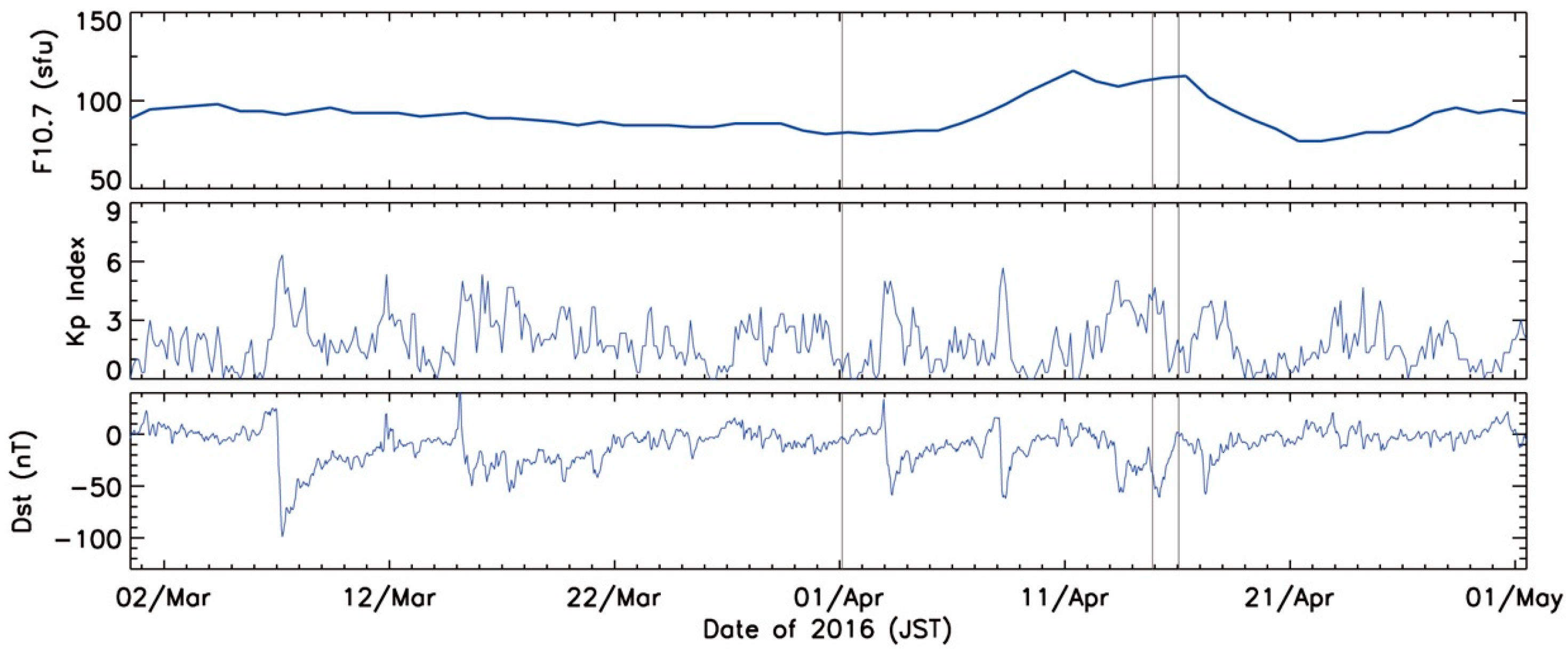
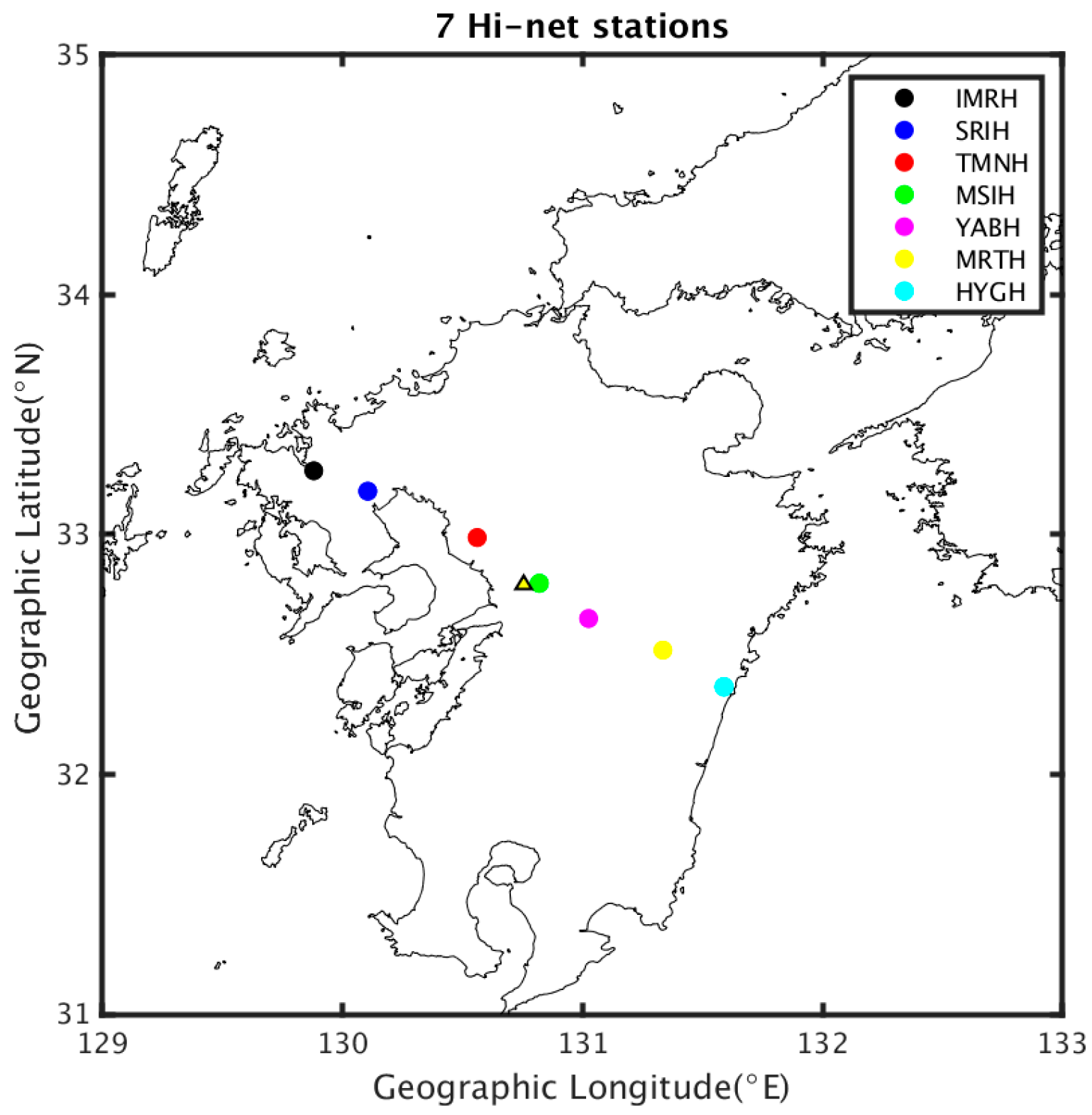
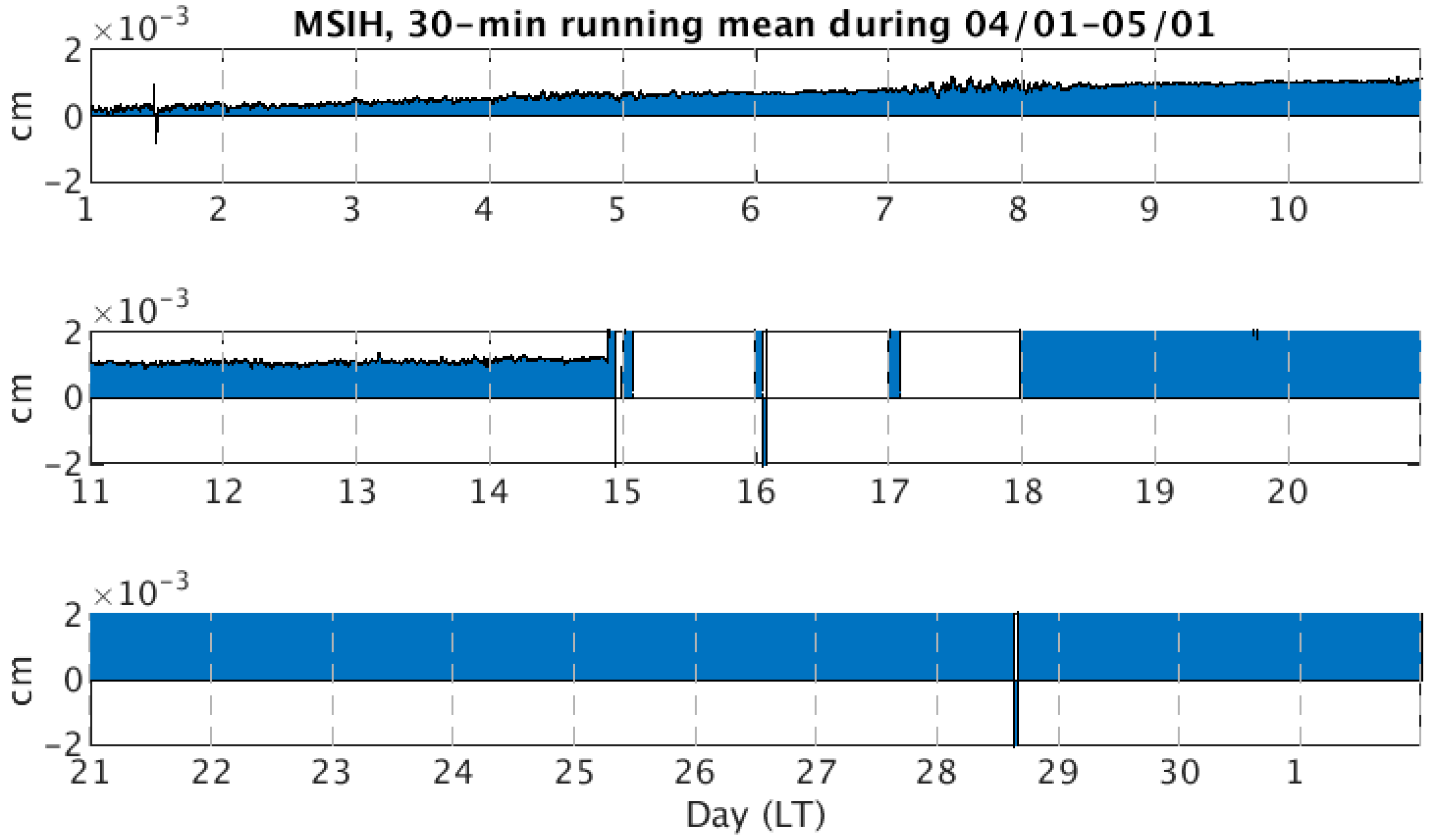
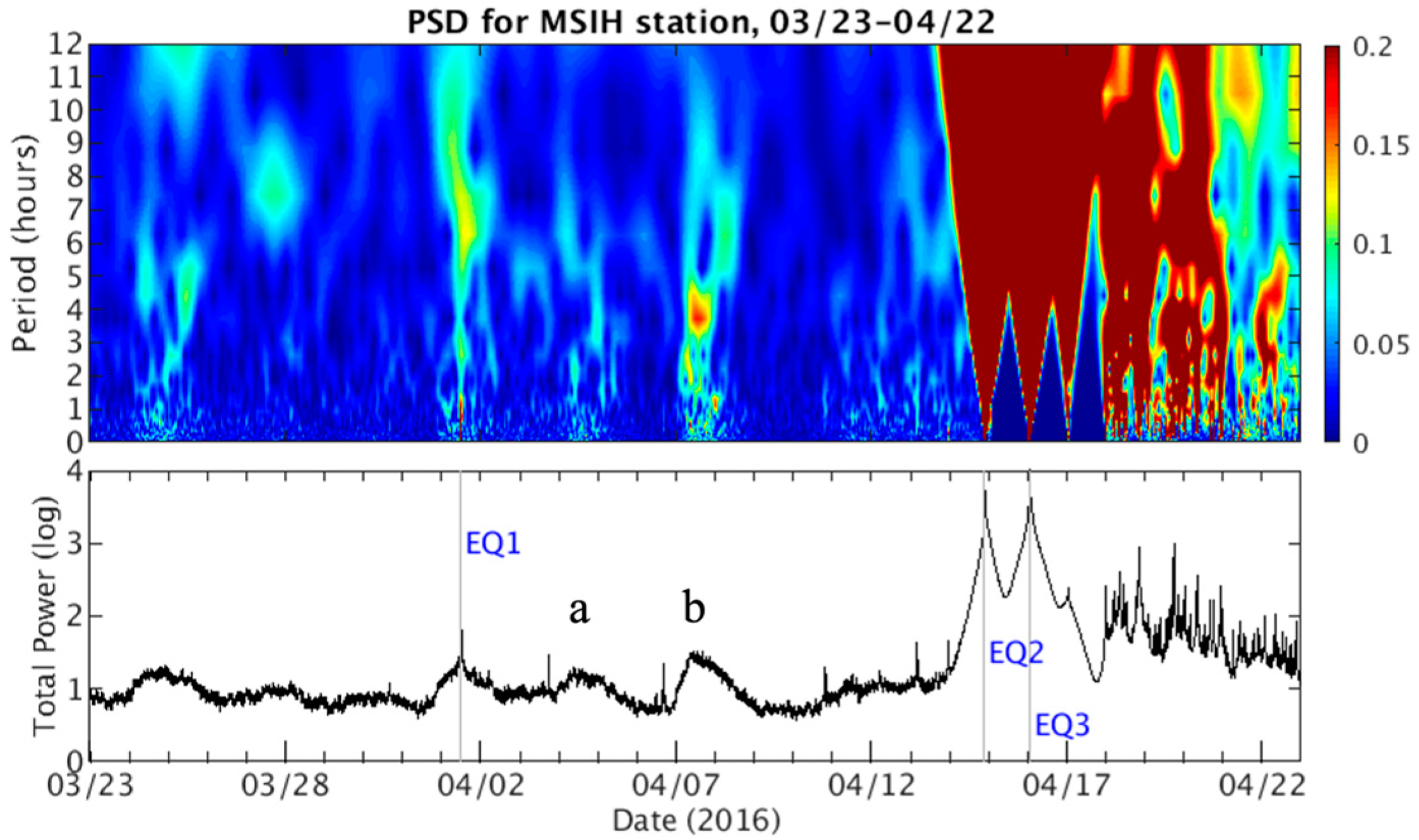
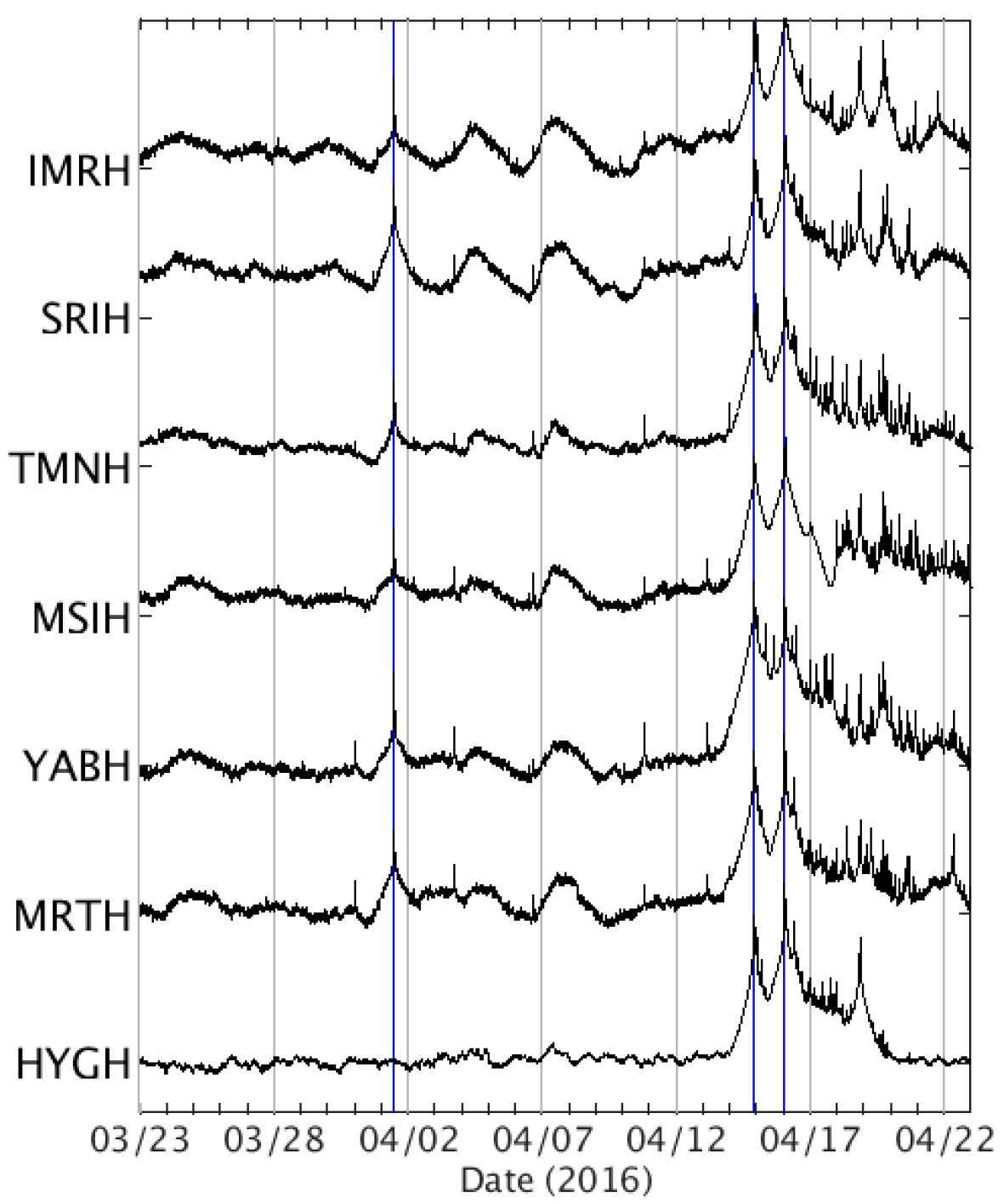
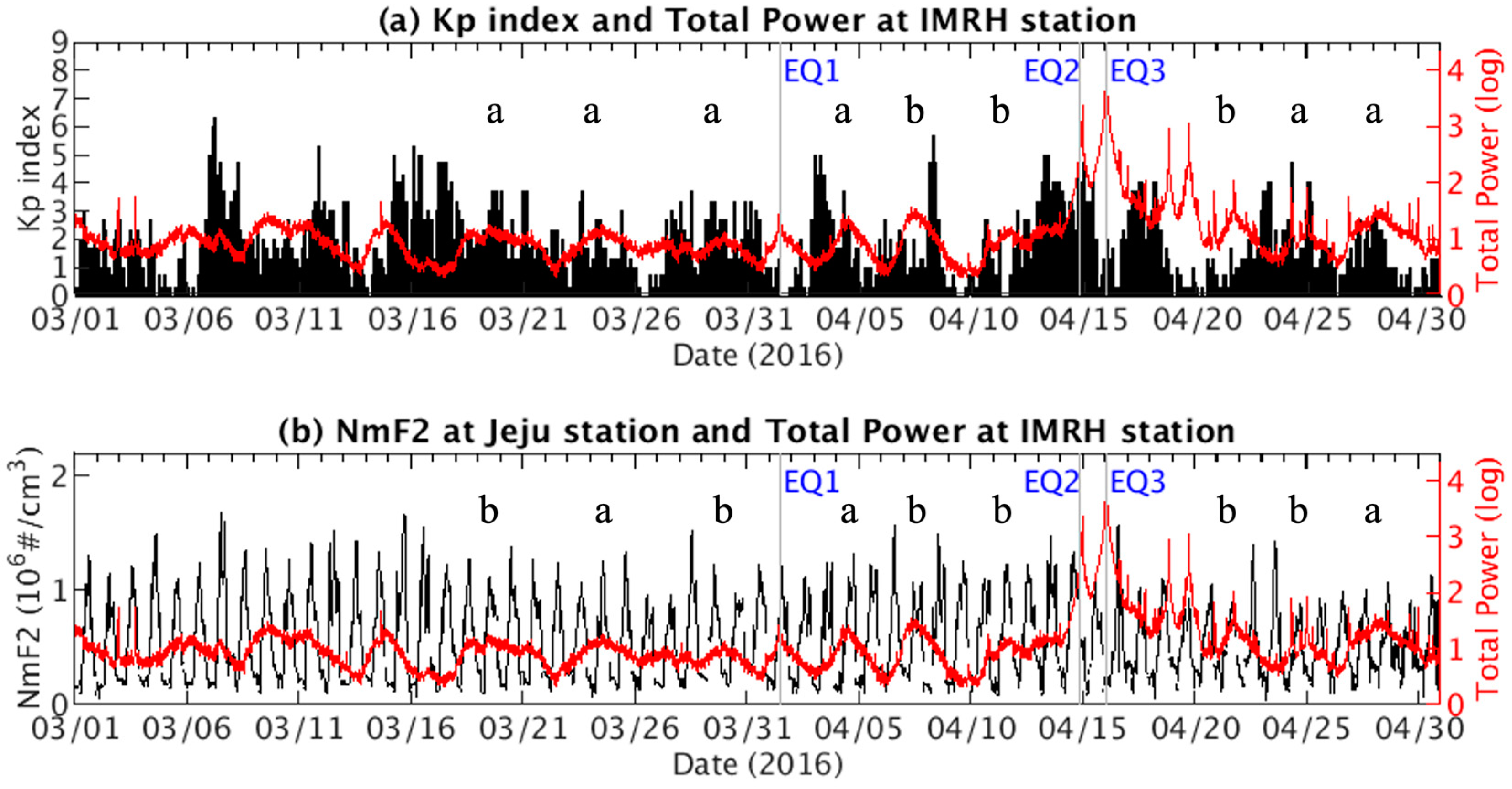
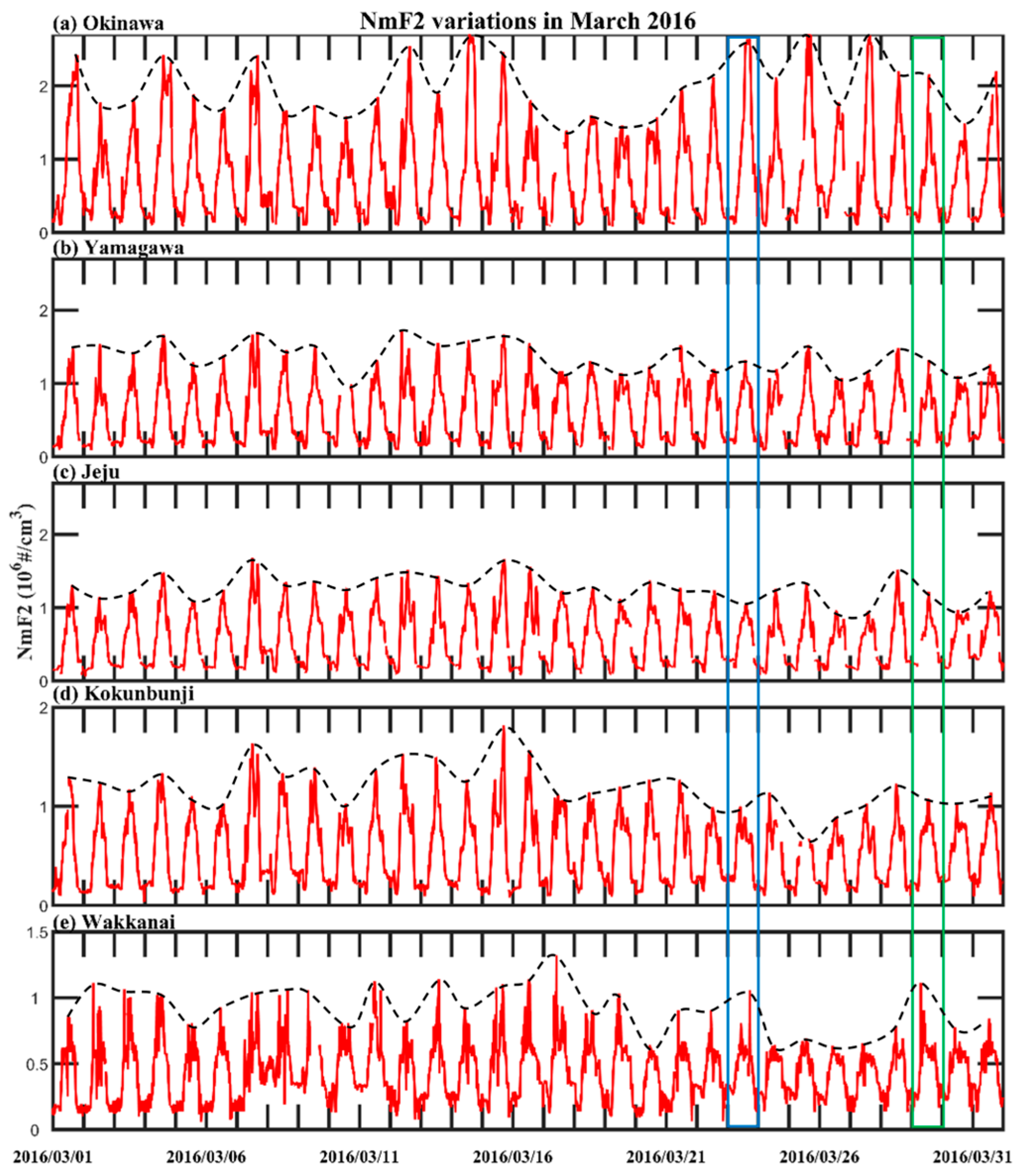
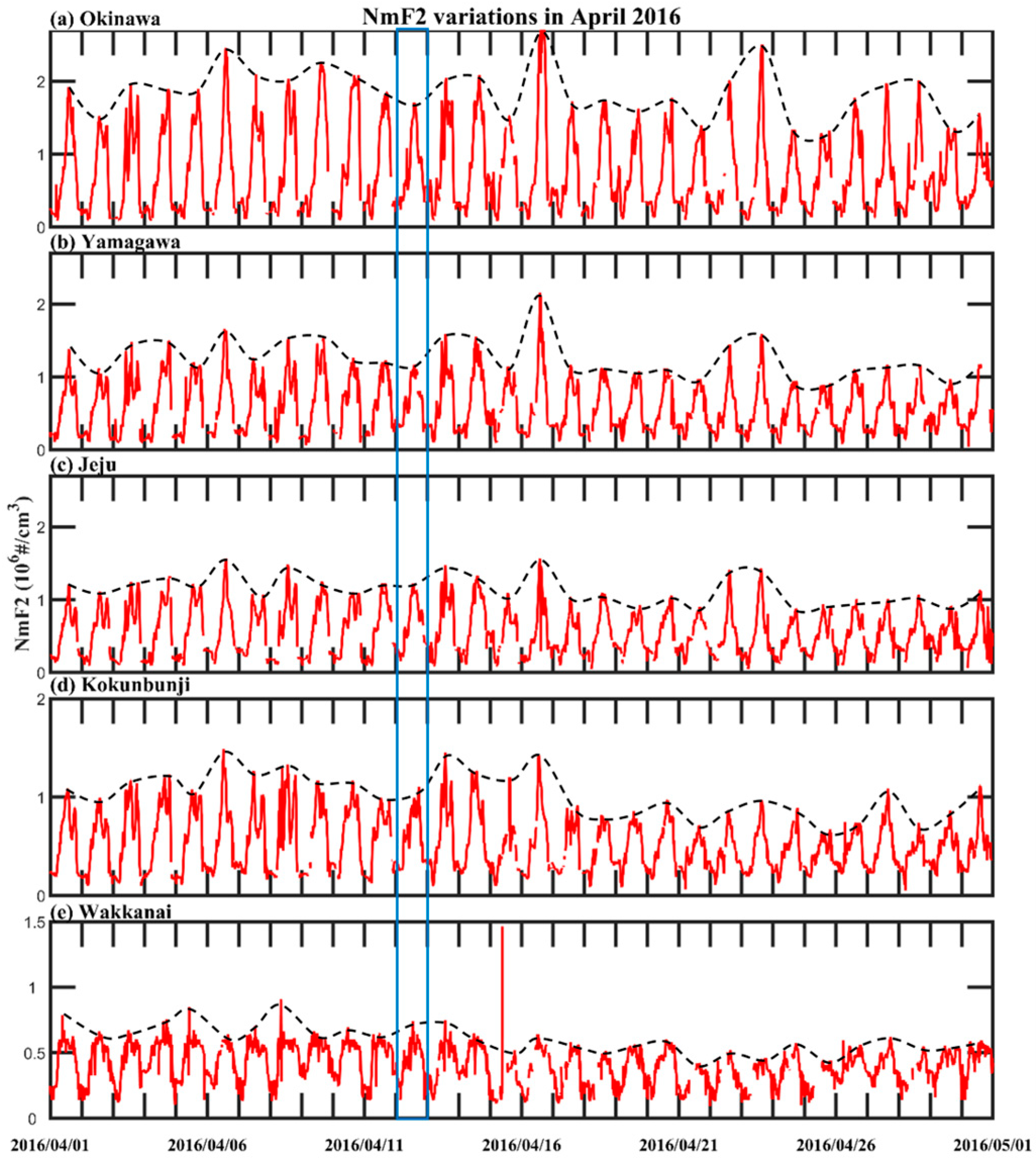
Disclaimer/Publisher’s Note: The statements, opinions and data contained in all publications are solely those of the individual author(s) and contributor(s) and not of MDPI and/or the editor(s). MDPI and/or the editor(s) disclaim responsibility for any injury to people or property resulting from any ideas, methods, instructions or products referred to in the content. |
© 2023 by the authors. Licensee MDPI, Basel, Switzerland. This article is an open access article distributed under the terms and conditions of the Creative Commons Attribution (CC BY) license (https://creativecommons.org/licenses/by/4.0/).
Share and Cite
Chen, C.-H.; Oyama, K.; Jhuang, H.-K.; Das, U. Driving Source of Change for Ionosphere before Large Earthquake -Vertical Ground Motion-. Remote Sens. 2023, 15, 4556. https://doi.org/10.3390/rs15184556
Chen C-H, Oyama K, Jhuang H-K, Das U. Driving Source of Change for Ionosphere before Large Earthquake -Vertical Ground Motion-. Remote Sensing. 2023; 15(18):4556. https://doi.org/10.3390/rs15184556
Chicago/Turabian StyleChen, Chia-Hung, Koichiro Oyama, Hau-Kun Jhuang, and Uma Das. 2023. "Driving Source of Change for Ionosphere before Large Earthquake -Vertical Ground Motion-" Remote Sensing 15, no. 18: 4556. https://doi.org/10.3390/rs15184556
APA StyleChen, C.-H., Oyama, K., Jhuang, H.-K., & Das, U. (2023). Driving Source of Change for Ionosphere before Large Earthquake -Vertical Ground Motion-. Remote Sensing, 15(18), 4556. https://doi.org/10.3390/rs15184556





